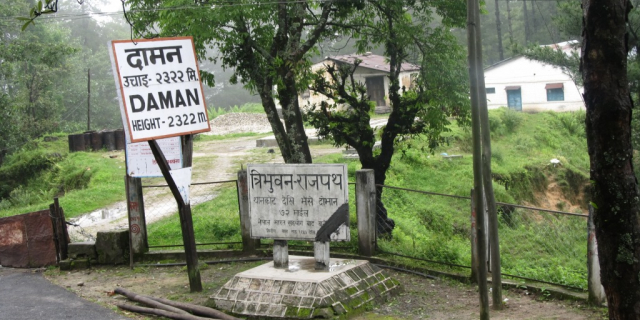The Bindhyabasini Temple (Nepali: बिन्ध्यबासिनी मन्दिर) is the oldest temple in the city of Pokhara, Nepal and is located in Ward No. 2, Miruwa. It regularly attracts a large number of locals, Nepalis from across the country and foreigners alike. The main temple is devoted to the goddess Bindhyabasini, a Bhagawati who is the incarnation of Kali. There are smaller temples of the goddess Saraswati, Shiva, Hanuman, and Ganesha on the premises. The temple is situated atop a small hill and can be accessed via stone staircases on the East and North East.
The views of the Himalayas from the North of the temple are breathtaking while from the South one can see the expanse of Pokhara city.
The temple was established circa 1760s.[1] King Girvan Yuddha Bikram Shah, the then king of Nepal appointed Kahindra Padhya Poudel in June 1815 AD as temple priest replacing Harivamsha Padhya. Its stated that the priest could use the Guthi Lands endowed for the temple to perform regular and ceremonial puja.[2]
The temple was built in 1842 B.S. in 47 ropanis of land. The legend of Bindhyabasini temple begins when the king of Kaski, Siddhi Narayan Malla or the king of Parbat, Khadgaman Malla dreamt about establishing a temple for the goddess. So, he ordered some of his men to bring back a statue of the goddess from present Uttar Pradesh of India.
During their journey, the men set up camps at the current temple location. However, the next morning they could not move on their journey because the deity could not be lifted from the camps. So, eventually, the temple was established in Mohariya Tole of Pokhara.
Since then this place has been a hub for worshippers. The meaning of ‘Bindhya” means incarnation of goddess and “Basini” means the dweller of a place.[3]
Legend on the establishment of the templeThe king of Kaski, Sidddhi Narayan Shah or the king of Parbat Khadgaman Malla saw a dream about establishing a temple for the goddess Bindhyabasini. He had his men go to Bindhyachal Parbat (currently in Uttar Pradesh, India) to bring back a statue of the goddess. The men when returning set up camp for a night at the current location of the temple. When they woke up the next morning to resume their journey, they found they couldn't lift the statue from the ground. When informed of the situation, the king directed his people to establish the temple, hence the beginning of Bindhyabasini Temple.
Most of Pokhara city was destroyed in the fire of 1949 and the fire was allegedly started in Bindhyabasini temple while performing an offering which later spread out of control.[4]
Common belief about goddess BindhyabasiniGoddess Bindhyabasini is commonly believed by the residents of Miruwa that she is the replacement for the eighth child (Lord Krishna) of Devaki and Vasudeva. When Kansa tries to kill the child, who's been exchanged, she, who's herself a Devi disappears and is in fact goddess Bindhyabasini.

































Add new comment